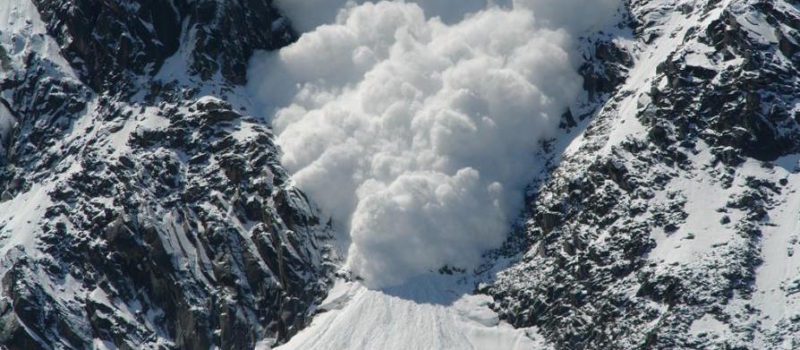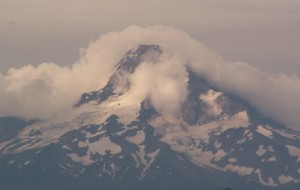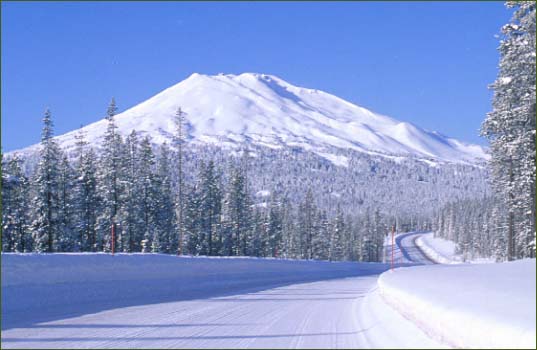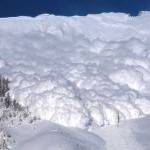Avalanche Safety
Generally, avalanches are not a major problem in Oregon. At least, not on your average Nordic Club ski trip. However, backcountry skiers and snowshoers should be attuned to the possibility of avalanches. There is an organization in Oregon dedicated to enhancing public awareness of avalanche hazards and safety measures. This is the Central Oregon Avalanche Association (COAA).
 Backcountry skier or not, every winter recreationalist should know some of the avalanche warning signs. There are several more-or-less technical indicators that can be used to determine the risk of an avalanche. Some of these are listed below.
Backcountry skier or not, every winter recreationalist should know some of the avalanche warning signs. There are several more-or-less technical indicators that can be used to determine the risk of an avalanche. Some of these are listed below.
But, common sense and a little observation can be useful too. Check for evidence of avalanche activity by looking around. Are there signs of vertical snow movement? Look for rough-looking, disturbed snow on a slope that is surrounded by smooth, undisturbed snow. If you see a gap in the tree cover of a slope, there’s a chance that the gap is a snow chute that sees periodic avalanche activity.
Avalanches tend to happen on slopes angled between 30 and 50 degrees. A slope may become avalanche prone after receiving heavy snow of an inch an hour for several hours. Rain, strong winds, and rapidly increasing temperatures can cause snow to
shift making it unstable.
Knowing recent snow history can be important. For example, several inches of new snow falling on a hard base can make the new snow prone to sliding. You can make a vertical cut in a snow bank to check the layering of the snow. If there is a soft or wet snow layer resting on a layer of hard snow, the soft layer can potentially “break away” and begin sliding over the hard snow.
There is a lot of avalanche information on the Internet. For example, to see a tutorial on avalanche signs and safety, visit http://www.avalanche.org/tutorial/tutorial.html.
 Although the Mt Hood area accounts for most of the avalanche deaths in Oregon, Central Oregon is not immune. In early January of this year, an avalanche near Paulina Peak claimed the life of a La Pine snowmobiler. Almost two years ago, a skier from Bend had to be rescued after triggering an avalanche in the same area.
Although the Mt Hood area accounts for most of the avalanche deaths in Oregon, Central Oregon is not immune. In early January of this year, an avalanche near Paulina Peak claimed the life of a La Pine snowmobiler. Almost two years ago, a skier from Bend had to be rescued after triggering an avalanche in the same area.
In the 90’s, a young man was killed by an avalanche near the Todd Lake turnoff while making a skiing/snowboarding film. According to Chris Sabo of the Deschutes National Forest, the steep rock wall located where the road to Todd Lake, Road 370, intersects Century Drive, can be one of the more dangerous places in our area when the conditions are right. In the past, the Forest Service has issued avalanche warnings for our area.
With these incidents in mind, it is comforting to know that there is an organization in our area, COAA, that is attempting to promote avalanche safety. COAA has both a website,www.coavalanche.org, and a Facebook page, http://www.facebook.com/pages/Bend-OR/Central-Oregon-Avalanche-Association/138739557498.
 The mission of the COAA is “To enhance Central Oregon public awareness of backcountry avalanche hazards and safety measures, promote winter snow safety, and provide information concerning snow conditions and weather to all winter recreationalists throughout Central Oregon.”
The mission of the COAA is “To enhance Central Oregon public awareness of backcountry avalanche hazards and safety measures, promote winter snow safety, and provide information concerning snow conditions and weather to all winter recreationalists throughout Central Oregon.”
As stated on the their website, the COAA was founded by a group Central Oregon winter recreationalists to promote increased avalanche awareness and to bolster local forecasting and tracking opportunities along the Cascade mountains of Central Oregon. The group is composed of backcountry skiers, alpinists, snowboarders, snowmobilers, and snowshoers.
The organization is currently raising funds to help achieve the following goals
- Increase information exchange through coordination with local guide and mountain snow safety experts.
- Promote and increase snowpack data and weather forecasting accuracy in Central Oregon by purchasing and installing Weather Stations and equipment at sites frequented by winter recreationalists.
- Maintenance and enhancement of the Backcountry Access Beacon Training Park at Mt. Bachelor.
- Increase public awareness by promoting avalanche transceiver clinics and backcountry safety procedures.
 For the 2009-2010 season, Mt. Bachelor and the Ski Patrol have received a Beacon Training Park courtesy of Backcountry Access. Beacon Training Parks are training systems created to make it easier for recreationists and professionals to practice with their locator beacons. At a beacon-training park, individual beacons can be turned on and off from a central control panel to create varied scenarios.
For the 2009-2010 season, Mt. Bachelor and the Ski Patrol have received a Beacon Training Park courtesy of Backcountry Access. Beacon Training Parks are training systems created to make it easier for recreationists and professionals to practice with their locator beacons. At a beacon-training park, individual beacons can be turned on and off from a central control panel to create varied scenarios.
The Mt. Bachelor beacon training park is located under the Red Chair in the West Village parking lot. Mt. Bachelor welcomes everyone to come practice beacon skills in a safe, educational, and fun environment.
Ron Hoyt

